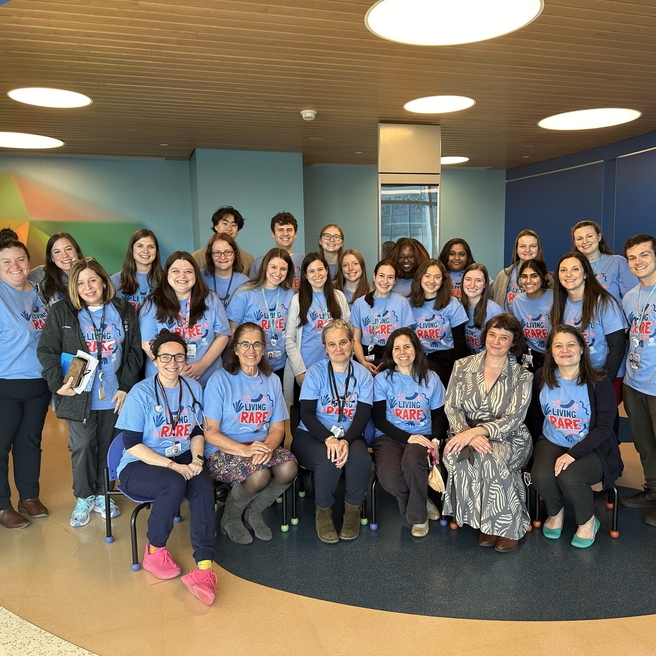What is 4H leukodystrophy?
4H leukodystrophy is a rare genetic disorder that affects the nervous system. The name is short for hypomyelination with hypogonadotropic hypogonadism and hypodontia. The condition is also known as 4H syndrome or Pol 3-related leukodystrophy.
Leukodystrophy is a group of conditions that affect the white matter of the brain. These diseases damage the myelin sheath, which surrounds and protects the nerve cells in the brain and spinal cord and speeds transmission of messages between cells.
The process of the body forming this protective myelin sheath is called myelination. Typically, myelination develops in the first few years of life. Hypomyelination means that the body is unable to produce myelin at normal levels. This prevents the body from completing normal myelination of the brain, and in some cases, the nerves outside the brain.
4H leukodystrophy is the combination of that myelin deficiency and two other conditions: hypogonadotropic hypogonadism (a condition that results in delayed puberty) and hypodontia (having fewer teeth than normal or an abnormal development of those teeth).
People with 4H leukodystrophy often have motor problems, including stiffness of the muscles and joints and problems with balance and coordination. They may also have movement disorders, including tremor or difficulty controlling smooth movements of their arms and legs. As infants, they may have delay in teething or have teeth appear in an unusual order. They are usually small for their age, and they do not go through typical puberty.
Causes of 4H leukodystrophy
4H leukodystrophy is caused by mutations in one of three genes: POL3RA, POL3RB and POLR1C.
4H leukodystrophy is inherited. That inheritance occurs only when both parents carry the genetic mutation, generally with no symptoms themselves. (This is called an autosomal recessive pattern of inheritance.) Pairs of each of our genes are inherited, one from each parent. If only one copy of a gene’s pair has the mutation, a person will not present with symptoms of 4H leukodystrophy, but will be a carrier of the condition. When two carriers have children together, the odds are one in four that any child they produce will have 4H leukodystrophy.
Signs and symptoms
Children with 4H leukodystrophy typically start to show symptoms in early infancy or as toddlers, though some don’t show signs of the disease until they are teenagers. People with 4H leukodystrophy have different combinations of symptoms. These symptoms can include:
- Problems with balance and walking. Over time, balance becomes a problem. Children with 4H leukodystrophy often appear to be clumsy and have frequent falls. They may develop an abnormal gait (way of walking) to compensate for balance problems, typically walking with their feet wide apart. Over time, children with the condition may lose the ability to walk.
- Stiff limbs (spasticity) and, in some cases, muscle contractions children cannot control, which can lead to twisted and unusual postures (dystonia).
- Problems with fine motor skills and muscle coordination (ataxia). Children may have trouble holding a pencil or bringing a cup to their lips. Children may also have tremor, further impacting their fine motor skills.
- Speech problems. Children with 4H can have difficult to understand speech (dysarthria) which impacts their ability to communicate even if they understand and know words and language.
- Learning disabilities. These can range from mild to severe, and may worsen over time. Some children with 4H leukodystrophy have no learning issues in early childhood, then develop mild learning problems as the disease progresses. Other children can develop normally through adolescence. It can be hard to accurately diagnose learning issues in children with 4H due to their motor problems.
- Abnormal tooth development. Some infants with 4H leukodystrophy are born with teeth that fall out during the first few weeks of life. Teeth may not appear in the usual sequence, with back teeth (molars) coming in before front teeth (incisors). Permanent teeth may not come in until adolescence. Teeth may also be unusually shaped. Most children with 4H leukodystrophy have fewer teeth than normal. However, some affected children have completely normal teeth.
- Small size. Some children with 4H leukodystrophy have lower-than-normal levels of growth hormone, which results in small stature. Some children may also have problems with thyroid function.
- Vision problems. Children with 4H may have nearsightedness (myopia) which can be severe. Additionally, motor problems may affect the ability of the eyes to move to follow an object which can further impact vision for complex tasks such as reading.
- Atypical puberty. Children with 4H leukodystrophy sometimes do not go through the average stages of puberty. This is caused by the fact that the brain does not signal the body to initiate puberty in a typical fashion (hypogonadotropic hypogonadism).
Testing and diagnosis for 4H leukodystrophy
Diagnosis of 4H leukodystrophy is made based on physical symptoms, imaging of the brain and results of genetic tests.
- Magnetic resonance imaging (MRI) of the brain is a key diagnostic tool, as it can detect patterns in brain tissue that are characteristic of 4H leukodystrophy.
- Genetic testing can identify changes in the POL3RA, POL3RB or POLR1C genes that are associated with 4H leukodystrophy. This analysis is done from a blood, saliva, or cheek swab sample.
- Blood tests for levels of thyroid, growth and puberty hormones can be helpful.
- Careful examination of the teeth, sometimes by a pediatric dentist with dental X-rays, can help identify missing, delayed or atypical teeth.
Treatment
There is no known cure for 4H leukodystrophy, but treatment is available to manage symptoms and improve the quality of children’s lives.
At Children’s Hospital of Philadelphia, your child’s care will be coordinated by our Leukodystrophy Center. Our multidisciplinary team provides advanced diagnostic testing, comprehensive clinical care, and the latest treatments available while we continue to seek new therapeutic options.
Clinical trials may also be an option. Your doctor can help you learn more about these studies. You can also find a list of ongoing studies at www.clinicaltrials.gov.

Your child's appointment
Find information about scheduling appointments with CHOP’s Leukodystrophy Center and what to expect during your first visit.
Follow-up care
Children with 4H leukodystrophy may need regular monitoring and support from a range of medical specialists and therapists in order to adapt treatment to changing needs. The care is geared to providing the highest possible quality of life and to address any symptoms that cause discomfort.
Resources to help
4H Leukodystrophy Resources
Leukodystrophy Center Resources
We have created resources to help you find answers to your questions and feel confident with the care you are providing your child.
Reviewed by Adeline Vanderver, MD
